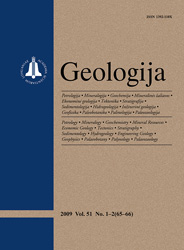 ISSN 1392-110X ISSN 2029-056X (online) |
2009 m. Nr. 1-2 The sedimentology of debris within basal ice,
the source of material for the formation of lodgement till: an example of the Russell
Glacier, West Greenland
The main objective of this research is to examine in detail the sedimentology of the debris contained within the basal ice of the Russell Glacier (West Greenland). This is of crucial importance as the entrainment and alteration of debris within basal ice provides information on the intial stage of basal till formation. Grain-size analysis was performed using a FRITCH shaker with a set of 19 screens. The obtained data were statistically processed by the Roszkov and Kulikov method using a statistical package SIETAN worked out at the Institute of Geology and Geography. The orientation and dip of the long axes of basal ice debris were measured in five exposures using a geological compass. In 21 samples, the content of debris within the basal ice ranged within 34.33–86.54% producing a mean value of 61%. The results of comparative grain-size analysis indicate that the debris within the basal ice of the Russell Glacier is distinguished by the highest portion of silt and sand fraction in comparison with the flow, till and material of lateral and terminal. These data were compared with the data of grain-size analysis of lodgement till of Lithuania. In the Lithuanian till, the content of clay is very high in comparison to the debris within the basal ice of the Russell Glacier. The index of relative entropy of grain size frequency distribution of the debris within the basal ice of the Russell Glacier. In set of 19 fractions moraines ranges from 0.948 to 0.986 and in the set of 6 fractions from 0.840 to 0.994. Meanwhile, in the aeolian sediments generated as a result of repeated reworking of similar glacial sediments near Kangerlussuaq it is 0.610 and 0.361 respectively. Comparison of varieties of glacial sediments shows that the index of relative entropy is higher for grain-size composition of debris within the basal ice (the average for 19 fractions is 0.972 and for 6 fractions 0.980). The grain-size distribution of material within the basal ice reflects a combination of the petrology of the eroded glacier bed and by debris comminution and mixing associated with ice deformation. During glacier movement, debris material is mechanically milled to a silt fraction. Clay particles appear only when a glacier flows across clayrich subglacial beds. The increase of the value of relative entropy (index of mixing) of grain-size distribution of eroded material is associated with equalization of the content of debris of different fractions in the mixing process (if the content of all fractions would be equal, the value of relative entropy would be one). The basal ice of glaciers can be viewed as the initial stage of lodgement till formation occurring during plastic flow of glacier which in turn strongly influences the grain-size structure of lodgement till. Keywords: West Greenland, Russell Glacier, sedimentology, glacial deposit, lodgement till, basal ice |
Issues:
2011 - Vol.53 No. 1, No. 2, No. 3 2010 - Vol.52 No. 1-4 2009 - Vol.51 No. 1-2, No. 3-4 2008 - Vol.50 No. 1, No. 2, No. 3, No. 4, No. Priedas 2007 No. 1, No. 2, No. 3, No. 4 2006 No. 1, No. 2, No. 3, No. 4 2005 No. 1, No. 2, No. 3, No. 4 2004 No. 1, No. 2, No. 3, No. 4 2003 No. 1, No. 2, No. 3, No. 4 2002 No. 1, No. 2, No. 3, No. 4 2001 No. 1, No. 2, No. 3, No. 4 |